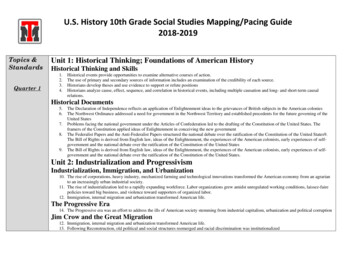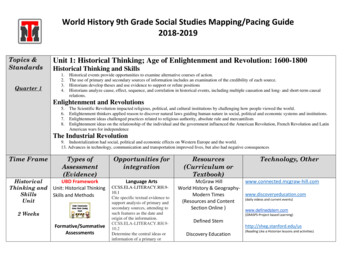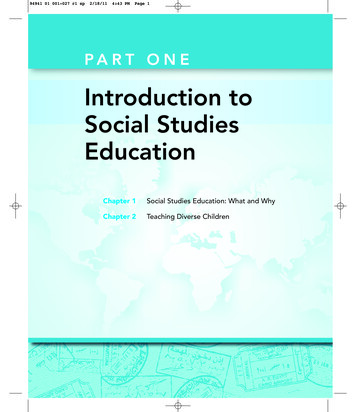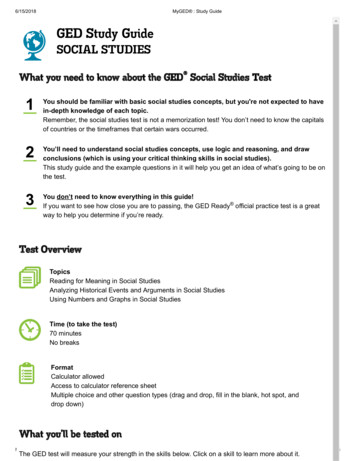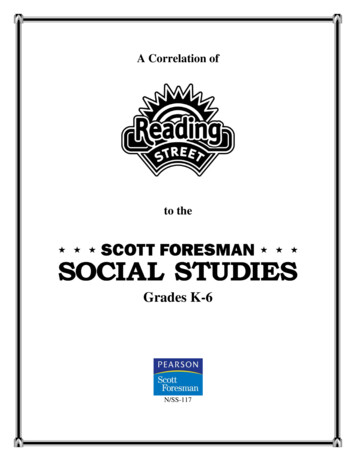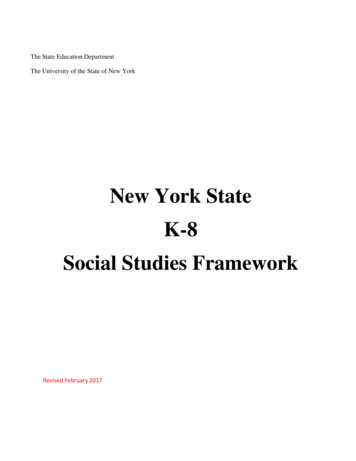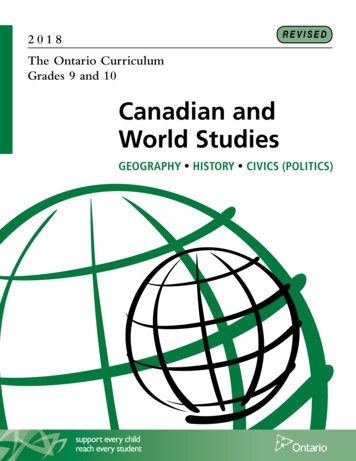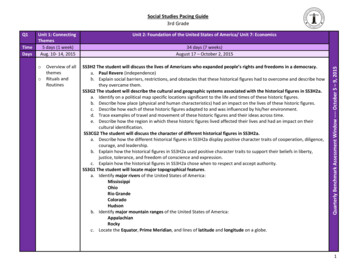
Transcription
Social Studies Pacing Guide3rd GradeTimeDaysUnit 1: ConnectingThemes5 days (1 week)Aug. 10- 14, 2015ooOverview of allthemesRituals andRoutinesUnit 2: Foundation of the United States of America/ Unit 7: Economics34 days (7 weeks)August 17 – October 2, 2015SS3H2 The student will discuss the lives of Americans who expanded people’s rights and freedoms in a democracy.a. Paul Revere (independence)b. Explain social barriers, restrictions, and obstacles that these historical figures had to overcome and describe howthey overcame them.SS3G2 The student will describe the cultural and geographic systems associated with the historical figures in SS3H2a.a. Identify on a political map specific locations significant to the life and times of these historic figures.b. Describe how place (physical and human characteristics) had an impact on the lives of these historic figures.c. Describe how each of these historic figures adapted to and was influenced by his/her environment.d. Trace examples of travel and movement of these historic figures and their ideas across time.e. Describe how the region in which these historic figures lived affected their lives and had an impact on theircultural identification.SS3CG2 The student will discuss the character of different historical figures in SS3H2a.a. Describe how the different historical figures in SS3H2a display positive character traits of cooperation, diligence,courage, and leadership.b. Explain how the historical figures in SS3H2a used positive character traits to support their beliefs in liberty,justice, tolerance, and freedom of conscience and expression.c. Explain how the historical figures in SS3H2a chose when to respect and accept authority.SS3G1 The student will locate major topographical features.a. Identify major rivers of the United States of America:MississippiOhioRio GrandeColoradoHudsonb. Identify major mountain ranges of the United States of America:AppalachianRockyc. Locate the Equator, Prime Meridian, and lines of latitude and longitude on a globe.Quarterly Benchmark Assessment Window ---- October 5 – 9, 2015Q11
Social Studies Pacing Guide3rd GradeSS3E1 The student will describe the four types of productive resources:a. Natural (land)b. Human (labor)c. Capital (capital goods)d. Entrepreneurship (used to create goods and services)SS3E2 The student will explain that governments provide certain types of goods and services in a market economy, andpay for these through taxes and will describe services such as schools, libraries, roads, police/fire protection, andmilitary.SS3E3 The student will give examples of interdependence and trade and will explain how voluntary exchange benefitsboth parties.a. Describe the interdependence of consumers and producers of goods and services.b. Describe how goods and services are allocated by price in the marketplace.c. Explain that some things are made locally, some elsewhere in the country, and some in other countries.d. Explain that most countries create their own currency for use as money.SS3E4 The student will describe the costs and benefits of personal spending and saving choices.2
Social Studies Pacing Guide3rd GradeUnit 3: Our Democratic Heritage39 days (8 weeks)October 5 – December 4, 2015SS3H1 The student will explain the political roots of our modern democracy in the United States of America.a. Identify the influence of Greek architecture (columns on the Parthenon, U. S. Supreme Court building), law, and the Olympic Gameson the present.b. Explain the ancient Athenians’ idea that a community should choose its own leaders.c. Compare and contrast Athens as a direct democracy with the United States as a representative democracy.SS3G1 The student will locate major topographical features.d. Locate Greece on a world map.SS3CG1 The student will explain the importance of the basic principles that provide the foundation of a republican form of government.a. Explain why in the United States there is a separation of power between branches of government and levels of government.b. Name the three levels of government (national, state, local) and the three branches in each (executive, legislative, judicial), includingthe names of the legislative branch (Congress, General Assembly, county commission or city council).c. State an example of the responsibilities of each level and branch of government.SS3H2 The student will discuss the lives of Americans who expanded people’s rights and freedoms in a democracy.a. Thurgood Marshall (civil rights)b. Explain social barriers, restrictions, and obstacles that these historical figures had to overcome and describe how they overcame themSS3G2 The student will describe the cultural and geographic systems associated with the historical figures in SS3H2a.a. Identify on a political map specific locations significant to the life and times of these historical figures.b. Describe how place (physical and human characteristics) had an impact on the lives of these historical figures.c. Describe how each of these historical figures adapted to and was influenced by his/her environment.d. Trace examples of travel and movement of these historical figures and their ideas across time.e. Describe how the regions in which these historical figures lived affected their lives and had an impact on their cultural identification.SS3CG2 The student will discuss the character of different historical figures in SS3H2a.a. Describe how the different historical figures in SS3H2a display positive character traits of cooperation, diligence, courage, andleadership.b. Explain how the historical figures in SS3H2a used positive character traits to support their beliefs in liberty, justice, tolerance, andfreedom of conscience and expression.c. Explain how the historical figures in SS3H2a chose when to respect and accept authority.Quarterly Benchmark Assessment Window ---- December 7 - 11, 2015Georgia Content Focus StandardsQ2TimeDays3
Social Studies Pacing Guide3rd GradeGeorgia Content Focus StandardsTimeDaysUnit 4: Life, Liberty, Pursuit of Happiness / Unit 5: Rights & Freedoms for Everybody / Unit 6: The Work Force in a Democracy/Unit 7: Rights of Workers in the United States52 days (11 weeks)December 7 – March 4, 2016SS3H2 The student will discuss the lives of Americans who expanded people’s rights and freedoms in a democracy.a. Frederick Douglass (civil rights)Susan B. Anthony (women’s rights)Mary McLeod Bethune (education)Lyndon B. Johnson (Great Society and voting rights)Franklin D. Roosevelt (New Deal and World War II)Eleanor Roosevelt (United Nations and human rights)César Chávez (workers’ rights)b. Explain social barriers, restrictions, and obstacles that these historical figures had to overcome and describe how they overcamethem.SS3G2 The student will describe the cultural and geographic systems associated with the historical figures in SS3H2a.a. Identify on a political map specific locations significant to the life and times of these historical figures.b. Describe how place (physical and human characteristics) had an impact on the lives of these historical figures.c. Describe how each of these historical figures adapted to and was influenced by his/her environment.d. Trace examples of travel and movement of these historical figures and their ideas across time.e. Describe how the regions in which these historical figures lived affected their lives and had an impact on their cultural identification.SS3CG2 The student will discuss the character of different historical figures in SS3H2a.a. Describe how the different historical figures in SS3H2a display positive character traits of cooperation, diligence, courage, andleadership.b. Explain how the historical figures in SS3H2a used positive character traits to support their beliefs in liberty, justice, tolerance, andfreedom of conscience and expression.c. Explain how the historical figures in SS3H2a chose when to respect and accept authority.Quarterly Benchmark Assessment Window ---- March 7 – 11, 2016Q34
Social Studies Pacing Guide3rd GradeBenchmark ReviewTime FrameInstructional DaysGeorgia Content FocusStandards Review Approximately 15 days (3 weeks)March 7 until GMAS EOG Social StudiesWhole group, small group and individual benchmarkreview based on spiraled formative benchmarkexam dataBenchmark Review and Next Grade Preview Approximately 20-25 days (4-5 weeks)Post-testing Window through End of School YearAdditional benchmark review for targeted non-proficiencystudentsCurrent grade enrichment5
Social Studies Pacing Guide3rd GradePertinent Assessment InformationQuarterly Benchmark AssessmentsQuarter 1 --- 25 questions (22 multiple choice questions and 3 short answer)Quarter 2 --- 34 questions (27 multiple choice questions, 4 fill in the blank, and 3 short answer)Quarter 3 --- 40 questions (33 multiple choice questions, 3 fill in the blank, and 4 short answer)Ga MilestonesQuestion Types 75 Selected-response itemso Four answer choices Incorrect choices, called distractors, usually reflect common errors The student’s task is to choose, from the alternatives provided, the best answer to the question posed in the stem (thequestion)Time Two sections 70 minutes per section Sections 1 and 2 must be scheduled to be administered on the same day in one test sessionGeorgia Milestones End ofGrade Measures: DomainStructures and Content WeightsSocial aphyGovernment and CivicsEconomicsSS3H1 (a-c), SS3H2 (a-b)SS3G1 (a-d), SS3G2 (a-c, e)SS3CG1 (a-c), SS3CG2 (a-c)SS3E1 (a-d), SS3E2, SS3E3 (a-d), SS3E430%20%30%20%6
Social Studies Pacing Guide 3rd Grade 2 SS3E1 The student will describe the four types of productive resources: a. Natural (land) b. Human (labor) c. Capital (capital goods) d. Entrepreneurship (used to create goods and services) SS3E2 The student will explain that governments provide certain
